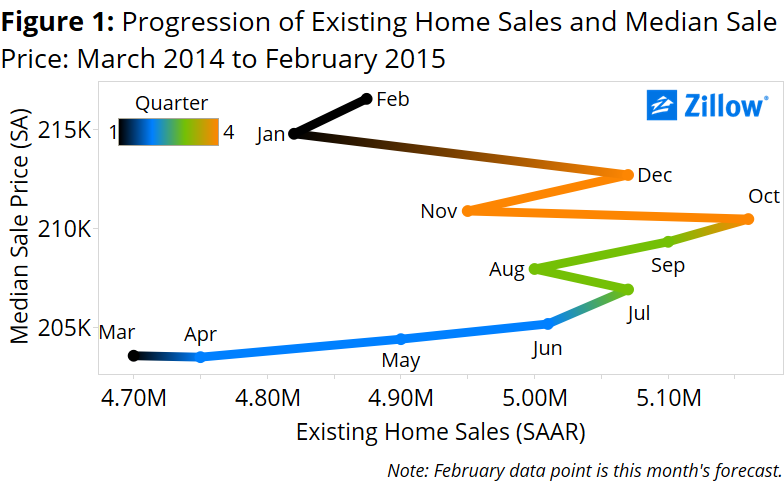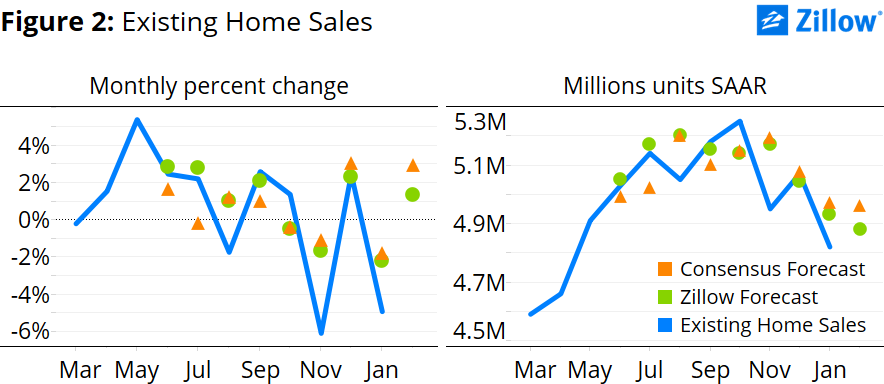- Zillow expects existing home sales to rise 1.3 percent to 4.88 million units (SAAR) in February.
- Although weak fundamentals – including a falling homeownership rate and flat interest rates – held back sales, there are potentially positive signals for the months ahead.
Zillow expects Monday’s February existing home sales data from the National Association of Realtors (NAR) to show an increase of about 1.3 percent to a seasonally adjusted annual rate (SAAR) of 4.88 million units, up from 4.82 million units (SAAR) in January.
Background
The market for existing homes stalled somewhat in the second half of 2014, pushing prices up at a rate faster than sales. Sales fluctuated around 5.05 million units (SAAR) between June and December 2014, before falling off sharply in January 2015. Sales did rise 3.2 percent in January year-over-year, but prices rose at a faster 5.4 percent rate (figure 1).

The single-unit homeowner vacancy rate fell half a percentage point in the fourth quarter of 2014, from 1.72 percent to 1.67 percent, but remains near 10-year lows as inventory remains historically tight. The homeownership rate also continued its decade-long decline, falling to 63.9 percent at the end of 2014. However, the rental vacancy rate also fell steeply in the fourth quarter of last year – more sharply than the homeowner vacancy rate – suggesting that the number of renter households continues to grow rapidly. Eventually, many of these renters will seek to become homeowners, which bodes well for home sales in the future.
The big story this month has to do with interest rates. While the rate on a 30-year fixed-rate mortgage had been declining fairly steadily since late 2013, this trend finally paused as rates have remained steady at 3.71 percent, unchanged from January.[ii] February marked only the third time since January 2014 that the headline, fixed mortgage rate did not fall from the previous month. This is significant because it comes at a time when markets are cautiously eyeing the Federal Reserve Board for signals about when it will increase the Federal Funds Rate.
Home sales are much less sensitive to interest rates than mortgage refinances, but rising rates will modestly increase the costs associated with buying a home. It is widely expected that the boost to home sales from improving job markets will outweigh any headwinds from rising mortgage interest rates.
February Forecast
Our existing home sales forecast uses a best-fit combination of two models, a structural model and a historical model. The models are in opposition this month, with the structural model suggesting a slight decrease, while the historical model has the needle pointing up.
The structural model suggests very little change in existing home sales, down just 0.2 percent month-over-month to 4.81 million units (SAAR). A little boost from unchanged mortgage interest rates, combined with movements in underlying fundamentals at the end of 2014 that are again expected to cancel each other out, should result in home sales having very little change from January.
The historical model suggests an increase of 1.4 percent, to 4.89 million units (SAAR). Pending home sales rose in January, bouncing back fully from December’s decline. But January’s improvements are not expected to have their largest contribution to sales until March, while the effect of December’s decline is likely to be felt the most in February. Recent movements in existing home sales are expected to outweigh movements in pending home sales, resulting in a positive forecast for February.
Using a best-fit combination of the two models, we obtain a point forecast of 4.88 million units (SAAR), a rise of about 1.3 percent from January (figure 2).

[i] We forecasted February’s median sale price using a best-fit ARIMA model – an ARIMA (5,1,0) in this case – to get a sense of the where the housing market will be this month in terms of a supply and demand framework. This forecast produced an increase of about 0.8 percent from January to $216,500 and is represented along with our sales forecast for February in figure 1.
[ii] According to Primary Mortgage Market Survey data provided by Freddie Mac.